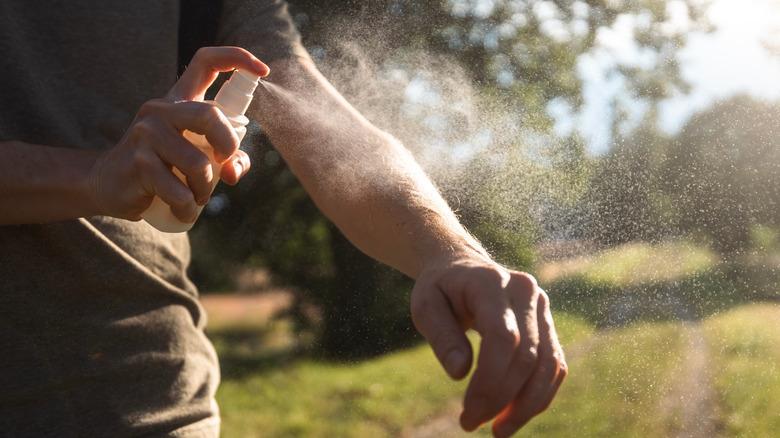Keep Ticks Away This Season With A DIY Repellent That Only Requires 3 Ingredients
We may receive a commission on purchases made from links.
Pests are a common problem in homes and yards and are often seen as an unavoidable evil. However, there are certain pests like ticks that pose more of a threat to your health than others, and protecting yourself (and your family and pets) should be a high priority. Ticks are parasitic bugs that feed on both human and animal blood. They are a particularly dangerous variety of pest as certain species are known to be carriers of serious diseases like Lyme, the potentially fatal Rocky Mountain spotted fever, Heartland virus, and more. Many of these tick-borne illnesses don't have vaccines to prevent them or specific medicines to treat them, which are just some of the reasons why it pays to be proactive about pest control (even if you don't have an issue now).
Different types of disease-carrying ticks can be found virtually all over the United States, and many homeowners have historically turned to chemical repellents to protect themselves and their yards and animals. Unfortunately, the continuous and widespread use of these products has started to result in some decline of their effectiveness. Fortunately, readily available essential oils may be an ace up your sleeve to help keep ticks at bay without chemicals. While there are a variety of home remedies to kill ticks that you can try, essential oils stand out as they actually have some science to back their use.
Make a tick repellant with citronella and thyme
Multiple studies have been conducted on essential oils to determine their effectiveness against pests, both as a repellent and acaricidal (meaning not just repelling, but killing). Oils like neem, eucalyptus, and lavender have all shown promise towards warding off ticks, but one superior combo that tested well for spatial repellency is thyme (lasts longer than other oils) and citronella (starts working quicker). To make your own essential oil DIY tick repellent, you'll need thyme and citronella essential oils (like Brooklyn Botany Citronella and Majestic Pure Thyme), a spray bottle, and some water. You'll use 10-15 drops of your citronella oil and five drops of thyme, plus two ounces of water.
Since oils don't mix well with water, it's best if you add something to aid the process, like castile soap, alcohol, or other specific solubilizers. If you want to use this mixture on your skin, add some coconut oil. The coconut oil will make the essential oils safer for direct skin contact while also prolonging their effectiveness. If you love natural solutions to your pest problems, then consider including an extra, low-maintenance safeguard with these 9 beautiful plants that may keep fleas and ticks from your yard.
Don't just repel, but kill ticks by adding this ingredient
We've got one more powerful ingredient you can add to your DIY tick spray: Cedarwood oil. Testing of cedarwood oil showed one of its main components, cedrol, was effective in not just repelling, but killing ticks. Results of a 2014 study published in Environmental Entomology showed that at certain doses, cedrol resulted in the death of four species of ticks (black legged, American dog, brown dog, and lone star) and at the highest dosage, 6.3mg/ml, it had a 100% mortality rate (talk about effective!). One important thing about these studies is that they used CO2-derived cedarwood oil, while most commercially available products are steam distilled. According to another study published in Phytochemical Analysis, the steam distillation process can destroy some of the original source's beneficial compounds and release more volatile organic compounds (VOCs) than the CO2-derived process. There are still some inexpensive CO2-derived options online, so make sure you grab those for your DIY mixture.
To add cedarwood oil to your DIY tick spray, double the amount of water listed previously (so another two ounces) and add 15 drops of CO2-extracted cedarwood oil. Don't forget to use coconut oil if you plan to use the mixture on your skin, or something like alcohol or witch hazel to help disperse the oils when used as a spray. Though there's science backing these essential oils, nothing is ever guaranteed, so it's important to discuss these options with your physician first and continue safety measures like avoiding long grassy areas and visually checking for ticks.


